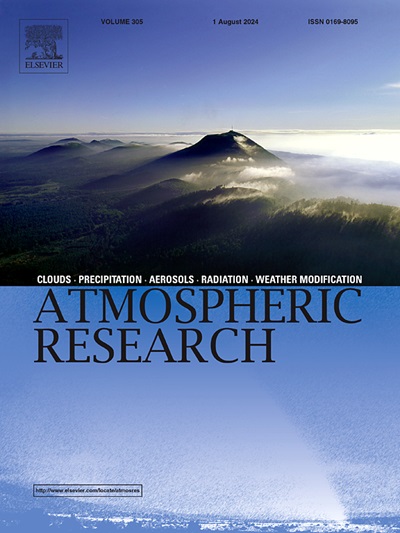Thermodynamics of extreme precipitation related to Atmospheric Rivers in two major Himalayan basins
IF 4.4
2区 地球科学
Q1 METEOROLOGY & ATMOSPHERIC SCIENCES
引用次数: 0
Abstract
In the extra-tropics, moisture is efficiently transported polewards in the lower troposphere through narrow bands of moisture transport, known as Atmospheric Rivers (ARs). This study identifies ARs that penetrate the southern Himalaya using 6-hourly Integrated Vapor Transport (IVT), and investigates the moisture dynamics, thermodynamics, and moisture sources of the top 8 AR events with substantial precipitation impacts in the Indus Basin (IB) and Ganga Basin (GB), to understand the mechanisms driving extreme AR-related precipitation. Most of these ARs produce over 150 mm/day precipitation (exceeding the 99th percentile of non-zero daily-precipitation) along their central axis and mountain landfall locations, and up to 50 mm/day in the plains. Even the glacierized regions that feed the main basins’ streams receive over 65 mm/day. High-intensity precipitation typically found near southern Himalaya, strongly corresponds to positive moisture convergence and positive advection, with minimal changes in atmospheric moisture content indicating effective translation of AR-moisture to precipitation. Different regions within the ARs experience distinct precipitation mechanisms, with mountains/foothills dominated by orographic uplift even under weak convective conditions, while areas near/on AR-axis are influenced by convective or frontal lifting. The presence of high moisture (IVT), saturated layers, and favourable thermodynamics highlights the ARs' capacity to generate intense precipitation when vertical lift is present. Excess moisture within ARs primarily originates from the Arabian Sea (north, east, and west), followed by Bay of Bengal (north and east), land-based evaporation, and smaller contribution from the Middle Eastern Seas. These case-specific findings demonstrate that ARs are key moisture transport mechanisms to mainland India and the Himalaya, delivering extreme localized precipitation strongly influenced by topography and position of ARs axis. This study offers the first comprehensive understanding of the dynamic and thermodynamic sources of AR moisture, associated precipitation, and the role of the Himalaya in extracting large amounts of moisture from ARs. These findings have important implications for understanding ARs contribution to extreme precipitation in IB and GB, driving mechanisms behind AR-precipitation, and the sources of high moisture content during ARs. These results can help explore potential risks of extreme precipitation, improve AR modeling, and forecasting ARs over these regions.
喜马拉雅两大盆地大气河流与极端降水的热力学关系
在温带地区,水汽在对流层下层通过被称为大气河(ARs)的水汽输送窄带有效地向极地输送。本研究利用6小时综合水汽输送(IVT)确定了穿透喜马拉雅南部的AR,并研究了在印度河流域(IB)和恒河流域(GB)产生大量降水影响的前8次AR事件的水分动力学、热力学和水分来源,以了解极端AR相关降水的驱动机制。这些区域沿中轴线和山地着陆点的大部分降水超过150毫米/天(超过非零日降水的第99百分位数),平原地区的降水高达50毫米/天。即使是为主要盆地的河流提供水源的冰川化地区,每天的降雨量也超过65毫米。高强度降水通常发生在南喜马拉雅附近,强烈对应于水汽正辐合和正平流,大气水分含量的微小变化表明ar水分有效转化为降水。ar内不同区域的降水机制不同,即使在弱对流条件下,山地/丘陵也以地形抬升为主,而ar轴附近/上的地区则受对流或锋面抬升的影响。当垂直抬升存在时,高水分(IVT)、饱和层和有利的热力学的存在突出了ARs产生强烈降水的能力。ARs内的过量水分主要来自阿拉伯海(北部、东部和西部),其次是孟加拉湾(北部和东部)、陆地蒸发和来自中东海的较小贡献。这些具体的研究结果表明,ar是向印度大陆和喜马拉雅地区输送水分的关键机制,提供受地形和ar轴位置强烈影响的极端局域降水。该研究首次全面了解了AR水分的动力和热力学来源、相关降水以及喜马拉雅在从AR中提取大量水分中的作用。这些发现对于理解ar对IB和GB极端降水的贡献、ar降水的驱动机制以及ar期间高含水量的来源具有重要意义。这些结果有助于探索极端降水的潜在风险,改进这些地区的AR建模和AR预测。
本文章由计算机程序翻译,如有差异,请以英文原文为准。
求助全文
约1分钟内获得全文
求助全文
来源期刊

Atmospheric Research
地学-气象与大气科学
CiteScore
9.40
自引率
10.90%
发文量
460
审稿时长
47 days
期刊介绍:
The journal publishes scientific papers (research papers, review articles, letters and notes) dealing with the part of the atmosphere where meteorological events occur. Attention is given to all processes extending from the earth surface to the tropopause, but special emphasis continues to be devoted to the physics of clouds, mesoscale meteorology and air pollution, i.e. atmospheric aerosols; microphysical processes; cloud dynamics and thermodynamics; numerical simulation, climatology, climate change and weather modification.
 求助内容:
求助内容: 应助结果提醒方式:
应助结果提醒方式:


